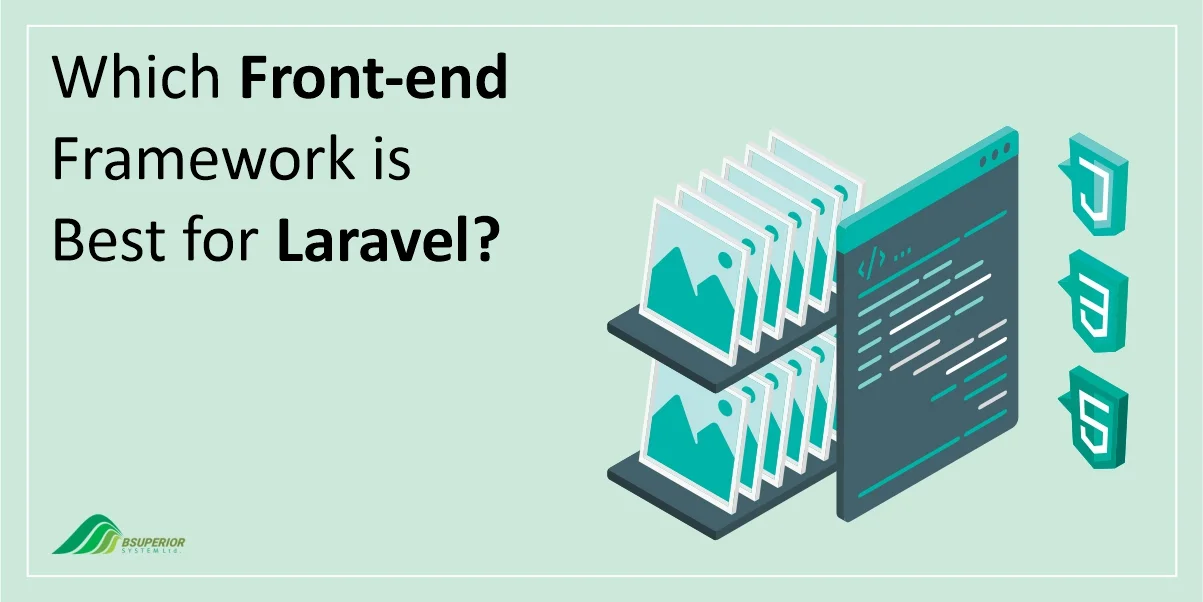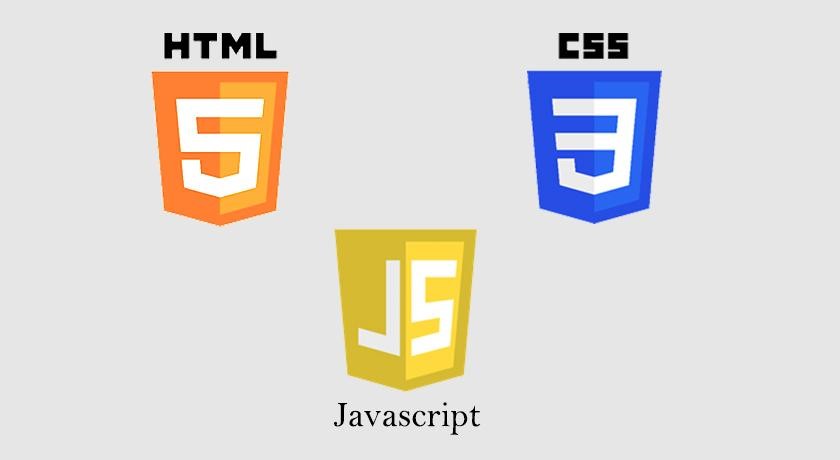Which Front-end Framework is Best for Laravel?

There are quite a few front-end frameworks available in the market that you can use for your Laravel projects. While all these frameworks will provide you with many benefits, they come with a number of limitations as well. That’s why, in this blog post we will share with you the best front-end frameworks that are ideal for Laravel projects. We will also explain their benefits and drawbacks to help you make a more informed choice.
Choosing a Front-end Technology
In the field of web development, the discourse on the optimal choice of design languages is often marred by numerous misinformed articles. While a multitude of technologies are employed in the creation of applications, the trifecta of JavaScript, HTML, and CSS forms the bedrock of web design.
The decision-making process regarding the appropriate front-end technology is a critical component of software development.
Certain frameworks demonstrate greater suitability for particular types of projects than others, and an ill-informed selection could precipitate inflated costs and extended timelines for product design and development.
As such, the importance of fostering a synergistic collaboration among consultants, developers, and clients cannot be overstated.
It is crucial in the initial stages of the software development cycle for the team members to garner comprehensive insights into the client’s needs and expectations. This enables them to proficiently delineate the specifications of the envisaged project.
This collaborative approach ensures that the front-end technology chosen aligns well with the project requirements, consequently improving efficiency and effectiveness in the software development process.
With a thoughtful and informed choice of front-end technology, developers can not only meet but also exceed the expectations of their clients.
The Appearance of the Application is Well-developed, What Does This Mean?
The success of powerful market software relies not only on robust back-end development but also on the creation of a suitable and user-friendly front-end. The front-end encompasses elements with which users interact and facilitates seamless communication with the back end.
The back-end refers to the underlying processes that connect with servers and databases. Its purpose is to ensure the correct and speedy loading of application content, as well as handle user requests and deliver the required data.
Front-end developers have the responsibility to ensure the responsiveness of the designed application. Nowadays, mobile devices have surpassed PCs as the primary means of accessing the internet.
Therefore, a responsive web layout that adjusts to different devices, such as smartphones, is crucial for providing a satisfying user experience.
Addressing potential errors is an integral part of front-end development. By implementing validation mechanisms, developers can minimize the adverse effects resulting from users entering incorrect inputs, thus enhancing the user experience (UX).
Additionally, in collaboration with application designers, front-end developers determine how the application will respond to network problems or server errors.
The Technologies Used in Front-end Development
In the realm of web development, front-end technologies play a pivotal role in ensuring an interactive and user-friendly interface. Predominantly, three languages have emerged as indispensable tools in this domain.
- HTML
- CSS
- JavaScript
According to the Stack Overflow Developer Survey released in 2023, JavaScript, HTML, and CSS were the most popular web development technologies. This continues a long trend, with JavaScript holding the top spot for eleven years in a row.
Another interesting point is that over 60% of the developers taking part in the survey picked JavaScript as their favorite language.
Learn More: CAN LARAVEL BE USED FOR BIG ENTERPRISE APPS?

Hypertext Markup Language (HTML)
HTML, or Hypertext Markup Language, is a unique form of markup language distinct from a programming language in that it does not perform computations or algorithms. Instead, HTML uses tags and concise code fragments to define the structure and content of web pages
The code is encompassed within an HTML text file, which the web browser scans, interprets, and subsequently presents as the visual representation of the website accessible to the end-user. HTML forms the backbone of website creation, ensuring accessibility across the broad spectrum of internet users.
Cascading Style Sheets (CSS)
CSS, or Cascading Style Sheets, operates in conjunction with HTML, utilizing selectors to identify which HTML elements should be influenced by the CSS code. This language is responsible for the aesthetic presentation of HTML elements across various devices with diverse screen sizes.
In other words, CSS facilitates the visual customization of websites, imparting unique styles, layouts, and responsive designs that enhance user experience. The styling parameters are stored within CSS files.
JavaScript
JavaScript is a versatile programming language, extensively deployed for both front-end and back-end development, thereby constituting what is commonly referred to as “full stack technology”.
It is JavaScript that imbues web applications with dynamism and interactivity, facilitating the creation of animated user interface components such as sliders, and pop-ups, among others.
This language enables web applications to respond intuitively to user interactions, thereby making web experiences more engaging and personalized.
Popular Front-end Frameworks

The evolution of JavaScript has engendered a multitude of frameworks and libraries that cater to a diverse range of project requirements.
These computational tools, consisting of prewritten code, significantly facilitate the swift implementation of intricate functionalities in software applications, effectively bypassing the need for developing code from the ground up.
Frameworks and libraries are instrumental in accelerating development timelines, augmenting code quality, and standardizing coding practices across projects. They provide robust foundations for developers to create highly interactive, responsive, and user-friendly web applications.
In this context, it’s pertinent to highlight the top three most popular frontend frameworks, each renowned for its unique strengths and capabilities. These are:
- React
- VusJS
- Angular
React
React.js, often referred to as React, is an open-source JavaScript library that empowers developers to construct dynamic user interfaces (UIs) with high efficiency and flexibility.
This powerful tool was originally conceived and developed by Facebook’s engineering team to address the need for a high-performing and flexible UI library for their complex applications.
Since its creation, React.js has gained widespread acceptance in the developer community due to its ability to improve the speed of development and the performance of applications.
One of the distinguishing features of React.js is its component-based architecture, which enables developers to encapsulate functionality and styling into reusable components.
This modular approach promotes code reuse, which can result in significant time savings during the development process, as well as improved maintainability of the codebase.
React.js is predominantly utilized in the realm of web application development, where it has proved invaluable for developing web applications with numerous dynamic elements, handling such tasks with finesse and efficiency.
However, with the advent of React Native, another powerful tool that extends React’s principles to mobile application development, React’s influence has expanded beyond the web.
React Native facilitates the development of native mobile apps for iOS and Android platforms using the same JavaScript and React architecture.
Learn More: TYPES OF WEB APPLICATIONS THAT CAN BE BUILT WITH LARAVEL WEB APPLICATION FRAMEWORK
Pros and Cons of Using Laravel with React
Embracing the integration of Laravel and ReactJS can furnish developers with several enhanced features and benefits, which, coupled with a thoughtful understanding of potential challenges, can lead to the creation of superior applications.
Pros:
- Modularity: Laravel and ReactJS’s architecture promotes modularity, enabling the development of code in manageable segments for improved maintainability and readability.
- Reusable Components: ReactJS’s support for creating and reusing components speeds up the development process. This reduces redundancy and promotes code consistency.
- Strong Community Support: The vast and vibrant communities around Laravel and ReactJS provide comprehensive support, timely updates, and a vast repository of shared knowledge.
- Ease of Use: The simplicity of Laravel, in conjunction with React’s component-based architecture, provides an intuitive development experience.
- Virtual DOM: ReactJS uses a Virtual DOM, which enhances application performance through efficient updating and rendering of components.
- Comprehensive and Fluid Documentation: Laravel and ReactJS’s well-detailed documentation aids in reducing the learning curve and boosting developer productivity.
- High Performance: Laravel’s backend capabilities, coupled with React’s user interface components, create a high-performance environment for applications.
- Scalability: Both Laravel and ReactJS are designed with scalability in mind, ensuring that your application can grow seamlessly over time.
Considerations:
- Multiple Development Approaches: While the flexibility of Laravel and ReactJS means multiple methods can achieve the same outcome, this can also be perceived as an opportunity to explore and learn different ways to solve a problem, stimulating creativity and problem-solving skills.
- Syntax Learning Curve: While ReactJS’s syntax may be complex compared to some alternatives, once mastered, it offers powerful tools for creating dynamic web applications. Moreover, plenty of resources are available for learning and overcoming these initial challenges.

VueJS
VueJS is a distinguished open-source progressive framework that is highly adaptable and versatile, making it an exceptional choice for an array of projects, particularly in building state-of-the-art web user interfaces and single page applications (SPAs).
Moreover, VueJS holds immense potential for mobile, web, and desktop development. The adoption of VueJS by industry giants serves as a testament to its efficacy and robustness.
In addition, it is engineered with a bountiful collection of tools that are not only lightweight but also significantly enhance SEO optimization and user experience when leveraged adeptly.
Pros and Cons of Using Laravel with Vue.js
There are a number of benefits and shortcomings related to Vue.JS that you need to consider.
Pros:
- Abundance of Online Resources: Imagine having a wealth of knowledge at your fingertips! VueJS’s bountiful online resources make it exceedingly easy for developers to find answers and solutions, essentially becoming an extension of your team.
- Comprehensive Documentation: Picture an intricate roadmap leading to your destination without any detours; that’s what VueJS’s documentation offers. It’s a treasure trove of information, guiding you through every step with precision, saving your valuable time.
- Ease of Use: What if development felt like a breeze? VueJS’s intuitive design allows even those new to programming to quickly get onboard. You’ll be building amazing applications in no time, making each development project a joy.
- Reactive Components: Imagine web elements that adapt and respond almost as if they were alive. With VueJS’s reactive components, you can create user interfaces that are not just dynamic, but also deliver blistering performance and real-time updates, keeping users glued to the screen.
- Single Page Applications: Envision a web experience so seamless that it feels like magic. With VueJS, you can build SPAs that are fast, sleek, and provide a fluid user experience, ensuring that your audience remains captivated and engaged.
Considerations:
- Occasional Complexity: While some may view complexity as a drawback, it’s actually an indicator of VueJS’s rich capabilities.
Tackling these complexities means unlocking advanced features that can set your project apart from the rest. It’s like discovering hidden treasures within an enchanted forest – utterly rewarding! - Language Barrier: Think of this as an opportunity for the global community to come together. The slight limitation in non-English documentation can be turned into a collaborative endeavor.
As more diverse developers adopt VueJS, this so-called “barrier” can be transformed into a bridge connecting cultures and coding practices. - Community Support: Rather than seeing the burgeoning community as a con, view it as an invitation to be a pioneer. You have the chance to be a part of something that’s growing.
As the community expands, so does the wealth of collective knowledge and resources, and your involvement can be a driving force in shaping VueJS’s future.
Angular
Angular, an illustrious framework conceived and nurtured by Google, is in harmony with a plethora of code editors cherished by developers.
Angular empowers developers to craft cutting-edge Single Page Web Applications (SPAs) and Progressive Web Applications (PWAs), and has earned its eminence by being embraced by multinational corporations.
Being an open-source platform, Angular’s crown jewel is its capacity to transform static HTML into dynamic HTML, effectively breathing life into your web pages. Moreover, Angular’s streamlined MVC architecture accentuates the reusability of components, making it a bastion of efficient web development.
Learn More: WHY CHOOSE LARAVEL FRAMEWORK FOR YOUR BUSINESS APPLICATION
Pros and cons of using Laravel with Angular
Let’s discuss some of the advantages and disadvantages that come with Angular.
Pros:
- Less Strenuous: Imagine development as a serene sail across calm waters; that’s Angular for you. Its refined architecture acts as a diligent assistant, lifting the burdens off your shoulders, and letting your creativity unfurl without hindrance. It’s an asset that understands you.
- Enhanced Performance: Visualize your applications with the agility of a cheetah and the strength of an elephant. Angular’s performance-enhancing features ensure that your applications don’t just run; they sprint with grace and power. Your users will revel in the sheer fluidity and robustness.
- More Responsive: Picture a digital environment that responds to each click and touch with finesse, holding your audience captive with its alacrity. Angular empowers you to build highly responsive interfaces that translate to an immersive and delightful user experience.
- Easy Development: Envision sculpting your dream project with the softest clay. Angular’s ease of development is like molding your ideas effortlessly into reality. Its intuitive and developer-friendly environment ensures that your journey from conception to completion is nothing short of poetic.
Considerations:
- Dynamic App Performance: While some have reported underwhelming performance in dynamic applications, Angular has continued to evolve. It listens and adapts, and with each iteration becomes more potent. It’s like a fine wine that gets better with time, and incorporating it now can mean getting ahead of the curve.
- Mandatory JavaScript Support: The requirement for JavaScript support isn’t a limitation, it’s a nudge towards modernity. In a world where most devices and browsers support JavaScript, this prerequisite ensures that your application stays compatible with the advancing technological landscape.
Laravel is the Most Popular PHP Framework
In the realm of web development, PHP stands as a formidable programming language, renowned for its efficacy in crafting web applications. To augment the productivity of developers and promulgate coding standards, a myriad of frameworks have emerged.
These frameworks, essentially a symphony of libraries and conventions, serve as a magic wand that transmutes a blank canvas into a tapestry of code without starting from the ground up.
Among the constellation of PHP frameworks, Laravel reigns supreme. Often referred to as the crown jewel of PHP frameworks, Laravel owes its regal status to an alchemy of robust capabilities and seamless access to PHP’s most celebrated functions.
Final Words: Which Front-end Framework is Better for Laravel?
As you stand at the crossroads of Laravel development services, contemplating which frontend framework harmonizes perfectly with Laravel, it is imperative to recognize that the answer is as unique as a fingerprint.
The quintessential framework for Laravel is entwined with your aspirations, prerequisites, and vision. The golden question is, which framework resonates with your symphony?
Ask yourself:
- Ease of Learning: Does the prospect of a gentle learning curve invigorate you? Your choice may lean towards a framework that embraces newcomers.
- Elegance of Syntax: Are you a connoisseur of code, seeking syntax that flows like poetry? Your sensibilities might find solace in a framework renowned for its syntactic grace.
- Velocity of Development and Performance: Does the thrill of speed enthrall you, both in development and performance? A high-octane framework may be your chariot.
- Prospect in the Job Market: Are you navigating the currents of career prospects? Consider a framework that holds a commanding presence in the job market.
- Community and Support: Does being part of a vibrant community warm your spirits? A framework with a strong, supportive community might be your haven.
- Specific Project Requirements: Are there unique demands or features intrinsic to your project? Your choice could hinge on the specialized capabilities of a particular framework.
Each frontend framework, be it Vue.js, React, Angular, or others, is akin to a gem in a crown, radiating its unique brilliance. The plethora of frameworks is formidable in its own right. However, your circumstances, preferences, and objectives are the compass that guides you to your ideal match.
We value your input and believe this content may enhance our services. However, it's under review. If you see room for improvement, please use the "Report an issue" button below. Your feedback helps us excel.
Contact us today at –– and speak with our specialist.




